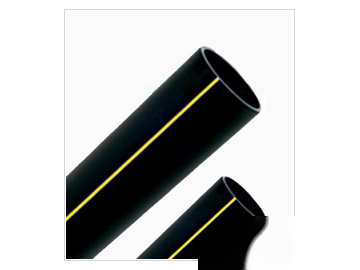
●Resistant to natural gas, liquefied gas, artificial coal gas, and other chemical corrosion, no secondary anti-corrosion required;
●Lightweight, high strength, and strong wear resistance;
●Attractive appearance, smooth inner and outer walls, low fluid resistance, and soft colors;
●Uses socket fusion welding and electrofusion socket welding, simple installation, good gas tightness, safe and reliable;
●Long service life, pipeline systems exceed 50 years under normal use, with low depreciation;
●Pipes can be coiled, easy to transport, and low construction costs;
●Good flexibility, earthquake resistance, and excellent impact resistance;
●Waste materials are recyclable and will not pollute the environment.

Polyethylene pipe connections generally use electrofusion connections and butt fusion methods. When connecting polyethylene pipes to metal pipes, steel-plastic transition joints or flange connections are used.
1. Electro-fusion connection: Suitable for the connection of pipes and electrofusion fittings, implementation steps are as follows:
① Cut the pipe with a rotary cutter to ensure the cross-section is perpendicular to the axis, mark the insertion depth, and use a rotary scraper to scrape off the PE oxidation skin on the surface.
② Wipe the dirt off the connection surfaces of the pipe and fittings with a clean cotton cloth.
③ Align the corresponding fittings during connection so that they are on the same axis, and insert the pipe into the fitting socket.
④ Use the electrofusion welding machine to heat according to the specified time, forming a uniform bead at the connection.
2. Butt fusion:
① Fix the two pipes on the welding machine fixture, use a milling cutter to mill the end faces of both ends and adjust to keep the central axis aligned.
② Adjust the heating time according to the pipe diameter and ambient temperature, and heat the ends of the two pipes with a heating plate.
③ After heating, remove the heating plate and quickly butt the ends together with pre-adjusted pressure, and cool to finish.
3. Steel-plastic transition joint connection:
① The PE end of the steel-plastic transition fitting is first connected to the PE pipe.
② The steel end of the steel-plastic transition fitting is connected to the metal pipe via threads, flanges, or welding methods.

| No. | Item | Performance Requirement | Test Standard | |
| 1 | Long-term static hydraulic strength, Mpa (20℃, 50 years, 95%) | ≥8.0 | GB15558.1-2003 | |
| 2 | Short-term static hydraulic strength Mpa | 20℃ | Toughness failure time 9.0 (h) ≥100 | |
| 80℃ | Brittle failure time 4.5 (h) ≥165 | |||
| Failure time 4.0 (h) ≥1000 | ||||
| 3 | Thermal stability (200℃), min | >20 | ||
| 4 | Resistance to stress cracking, h (80℃, 4MGpa) | ≥1000 | ||
| ≥170 | ||||
| 5 | Compression recovery (80℃, 4MGpa) | >170 | ||
| 6 | Longitudinal shrinkage rate (110℃), % | ≤3 | ||
| 7 | Elongation at break % | ≥350 | ||
| 8 | Weather resistance (after the pipe material accumulates ≥3.5KMJ/㎡ aging energy) | Still meets the performance requirements of item 2.3.7 and maintains good welding performance | ||
| Note: Suitable for natural gas, artificial coal gas, and liquefied petroleum gas with working temperatures ranging from -20℃ to 40℃ and maximum working pressure ≤0.4Mpa. | ||||

●Urban water supply pipeline network system
●Rural and urban drinking water pipelines
●Liquid transportation pipelines for industries such as chemicals, chemical fibers, food, forestry, dyeing, pharmaceuticals, light industry, papermaking, metallurgy, etc.
●Agricultural irrigation pipelines
●Telecommunications and power cable protection conduits
●Mining slurry transport pipelines













